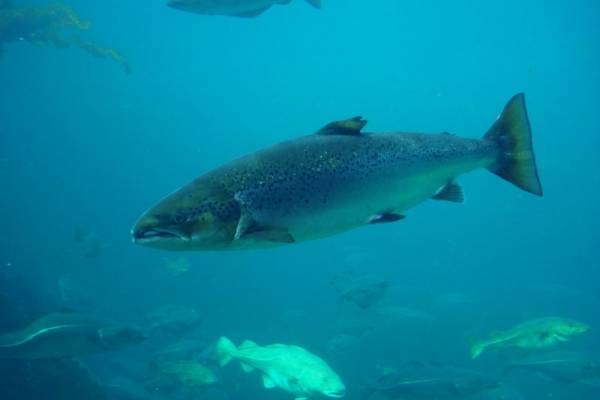Sushihunter
Active Member
http://www.thetechherald.com/article.php/200834/1782/Salmon-tracked-using-new-technology
Salmon tracked using new technology
by Rich Bowden - Aug 18 2008, 21:15
Img: Adult Atlantic Salmon. Credit: Hans-Petter Fjeld

Scientists seeking to better understand the worrying decline and slow recovery of the once-abundant Atlantic salmon, are turning to revolutionary new tracking technology, similar to that used in highway toll booths, in order to follow the fish.
The NOAA's Northeast Fisheries Science Centre (NEFSC) tagged 150 salmon smolts (juvenile fish) in Maine's Penobscot River and released them in Brewer, Maine in mid-May. Of these, 30 have successfully crossed a line of underwater receivers off Halifax, Nova Scotia, the first to be tracked using the new global Ocean Tracking Network, said NEFSC.
"The tracking system is deployed and working, which is great news," enthused John Kocik, who leads the tagging project with colleague James Hawkes at the NEFSC's Maine Field Station in Orono, Maine.
"We started ultrasonic tagging programs in Maine in 1997 and have learned much about salmon ecology in the estuaries and bays of the Gulf of Maine," Kocik said. "Our team is really excited that fish from our most recent work in the Penobscot River have been detected so far along on their migration northward. The first data provided valuable information about how long it took Atlantic salmon from the Penobscot River to reach Halifax."
The technology works by transmitting a unique ultrasonic code from each salmon every few seconds. Researchers are able to track the movements of the fish through the network of more than 80 acoustic receivers that extend from Brewer, on the Penobscot River near Bangor, into the Gulf of Maine. Acting like an EZ pass system at highway toll booths, the receiver records the identity and time of detection as the fish swims past.
The technology is superior to traditional fish tracking techniques in that it gives scientists an insight into fish movements as well as their survival rate.
While only 30 of 150 ultrasonically tagged fish have been detected in the current experiment, according to NEFSC, the early data suggests that many young salmon are surviving their migration north to feed and grow in waters of the Labrador Sea, coastal West Greenland and northern Canada.
"Given the fact that we are looking for a fish that is still less than a foot long that could be anywhere in the Northwest Atlantic Ocean, finding them in such apparent concentrations hundreds of miles from Brewer, Maine is remarkable and very encouraging," Kocik said. "Broad-scale ocean arrays such as the Halifax Array are a great tool to examine the marine ecology of such an uncommon fish in a large marine environment."
"Atlantic salmon are an iconic fish, but they're endangered and people want to know what's happening to the population," commented Mike Stokesbury, director of research for the Ocean Tracking Network. "This is the first step to finding out where the salmon are dying and what's causing the decline."
Jim's Fishing Charters
www.JimsFishing.com
http://ca.youtube.com/user/Sushihunter250
Salmon tracked using new technology
by Rich Bowden - Aug 18 2008, 21:15
Img: Adult Atlantic Salmon. Credit: Hans-Petter Fjeld

Scientists seeking to better understand the worrying decline and slow recovery of the once-abundant Atlantic salmon, are turning to revolutionary new tracking technology, similar to that used in highway toll booths, in order to follow the fish.
The NOAA's Northeast Fisheries Science Centre (NEFSC) tagged 150 salmon smolts (juvenile fish) in Maine's Penobscot River and released them in Brewer, Maine in mid-May. Of these, 30 have successfully crossed a line of underwater receivers off Halifax, Nova Scotia, the first to be tracked using the new global Ocean Tracking Network, said NEFSC.
"The tracking system is deployed and working, which is great news," enthused John Kocik, who leads the tagging project with colleague James Hawkes at the NEFSC's Maine Field Station in Orono, Maine.
"We started ultrasonic tagging programs in Maine in 1997 and have learned much about salmon ecology in the estuaries and bays of the Gulf of Maine," Kocik said. "Our team is really excited that fish from our most recent work in the Penobscot River have been detected so far along on their migration northward. The first data provided valuable information about how long it took Atlantic salmon from the Penobscot River to reach Halifax."
The technology works by transmitting a unique ultrasonic code from each salmon every few seconds. Researchers are able to track the movements of the fish through the network of more than 80 acoustic receivers that extend from Brewer, on the Penobscot River near Bangor, into the Gulf of Maine. Acting like an EZ pass system at highway toll booths, the receiver records the identity and time of detection as the fish swims past.
The technology is superior to traditional fish tracking techniques in that it gives scientists an insight into fish movements as well as their survival rate.
While only 30 of 150 ultrasonically tagged fish have been detected in the current experiment, according to NEFSC, the early data suggests that many young salmon are surviving their migration north to feed and grow in waters of the Labrador Sea, coastal West Greenland and northern Canada.
"Given the fact that we are looking for a fish that is still less than a foot long that could be anywhere in the Northwest Atlantic Ocean, finding them in such apparent concentrations hundreds of miles from Brewer, Maine is remarkable and very encouraging," Kocik said. "Broad-scale ocean arrays such as the Halifax Array are a great tool to examine the marine ecology of such an uncommon fish in a large marine environment."
"Atlantic salmon are an iconic fish, but they're endangered and people want to know what's happening to the population," commented Mike Stokesbury, director of research for the Ocean Tracking Network. "This is the first step to finding out where the salmon are dying and what's causing the decline."
Jim's Fishing Charters
www.JimsFishing.com
http://ca.youtube.com/user/Sushihunter250

